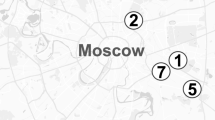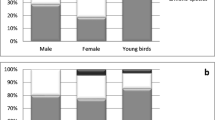Abstract
A total of 1267 microfungi, including 35 Myxomycetes, were recorded from the fecal samples of the 60 horses; of these 395 were found on 20 saddle-horse feces, 363 on 20 race-horses and 509 on 20 working-horses. Eighty two species representing 53 genera were recorded; of these 7 were Zygomycetes, 18 Ascomycetes, 1 Basidiomycetes and 25 Fungi Imperfecti: 2 Myxomycetes. Common coprophilous fungi are in decreasing orderPilobolus kleinii, Saccobolus depauperatus, Mucor hiemalis, Lasiobolus ciliatus, Podospora curvula, Petriella guttulata, M. circinelloides, Coprinus radiatus, Dictyostelium mucoroides, Sordaria fimicola, C. miser, C. stercorarius, Acremonium sp., Coprotus granuliformis, Graphium putredinis, Iodophanus carneus, Chaetomium murorum, Podospora communis, P. inaequalis, P. setosa, Saccobolus versicolor andCladosporium cucumerinum. Species ofMyrothecium verrucaria, Actinomucor elegans, Kernia nitida, Spiculostilbella dendritica andMucorparvispora were found exclusively in working-horses feces.Badhamia sp., Anixiopsis stercoraria, Echinobotryum state ofD. stemonitis, Geotrichum candidum andOidiodendron sp. were found only in saddle-horses feces.Chlamidomyces palmarum andPhilocopra sp. were found exclusively in race-horses feces.
Notes on infrequent or interesting fungi includeThamnostylum piriforme, Phialocephala dimorphospora, Rhopalomyces elegans andSpiculostilbella dendritica.
Similar content being viewed by others
References
Angel, K. & Wicklow, D. T., 1974. Decomposition of rabbit faeces; an indication of the significance of the coprophilous microflora in energy flow schemes. J. Ecol. 62: 429–437.
Angel, K. & Wicklow, D. T., 1975. Relationship between coprophilous fungi and faecal substrates in Colorado grassland. Mycologia 67: 63–74.
Arx, J. A. von., 1970. In: The genera of fungi sporulating in pure culture, p. 247. J. Cramer, Lehre.
Arx, J. A. von., 1975. Revision of Microascus with the description of a new species. Persoonia 8: 191–197.
Arx, J. A. von., 1978. Notes on Microascaceae with the description of two new species. Persoonia 10: 23–31.
Barron, G. L., Cain, R. F. & Gilman, J. C. 1961. The genus Microascus. Canad. J. Bot. 39: 1609–1631.
Brummelen, J. van., 1967. A world-monograph of the genera Ascobolus and Saccobolus (Ascomycetes, Pezizales). Persoonia (Suppl.) I: 1–260.
Brummelen, J. van., 1976. Some new species of Saccobolus. Persoonia 8: 421–430.
Dickinson, C. H. & Underhay, V. H. S., 1977. Growth of fungi in cattle dung. Trans. Brit. Mycol. Soc. 69: 473–477.
Harper, J. E. & Webster, J., 1964. An experimental analysis of the coprophilous fungus succession. Trans. Brit. Myc. Soc. 47: 511–530.
Ikediugwu, F. E. O. & Webster, J., 1970a. Antagonism between Coprinus heptamerus and other coprophilous fungi. Trans. Brit. Mycol. Soc. 54: 181–204.
Ikediugwu, F. E. O. & Webster, J., 1970b. Hyphal interference in a range of coprophilous fungi. Trans. Brit. Mycol. Soc. 54: 205–210.
Kendrick, W. B., 1961. The Leptographium complex, Phialocephala gen. nov. Canad. J. Bot. 39: 1079–1085.
Kimbrough, J. W., 1966. Studies in the Pseudoascoboleae. Canad. J. Bot. 44: 685–704.
Kimbrough, J. W., 1970. Segregates of Ascophanus, Coprotus vs. Leporina (Thelebolaceae, Pezizales). Taxon 19: 779–781.
Kimbrough, J. W., 1972. Ascal structure, ascocarp ontogeny, and a natural classification of the Thelebolaceae. Persoonia 6: 395–404.
Kimbrough, J. W. & Korf, R. P., 1967. A sinopsis of the genera and species of the tribe Theleboleae (= Pseudoascoboleae). Amer. J. Bot. 54: 9–23.
Larsen, K., 1971. Danish endocoprophilous fungi, and their sequence of occurrence. Bot. Tidsskr. 66: 1–32.
Lazo, W., 1979. Hongos coprofilos de Chile I. Segunda Reunion Nacional de Botanica. Sept., 1979. Santiago, Pontificia Universidad Catolica de Chile.
Lundqvist, N., 1972. Nordic Sordariaceae s. lat. Symbolae Botanicae Upsalienses 20, 1: 374 Uppsala.
Lodha, B. C., 1974. Decomposizion of digested litter. In: Biology of plant litter decomposition. Vol. I. (Ed. Dickinson, C. H. & Pugh, G. J. F.) pp. 213–241. London, Academic Press.
Malloch, D. & Cain, R. F., 1971. The genus Kernia. Canad. J. Bot. 49: 855–867.
Mirza, J. H. & Cain, R. F., 1970. Revision of the genus Podospora. Canad. J. Bot. 47: 1999–2048.
Moravec, J., 1971. Diskomycety cěledi Thelebolaceae (Brumm). Eckbl. zokresu Mladá Boleslav v Čechách. Čes. Mykol. 25: 150–160.
Morris, E., 1963. Three Hansfordia-like Stilbellaceous Genera. Am. Midl. Nat. 69: 99–105.
Nagy, L. A. & Harrower, K. M., 1979. Analysis of two southern hemisphere coprophilous fungus successions. Trans. Brit. Mycol. Soc. 72: 69–74.
Petersen, R. H., 1960. Some soil and coprophilous fungi from the South Pacific area. Mycologia 52: 552–556.
Richardson, M. J., 1972. Coprophilous ascomycetes on different dung types. Trans. Brit. Mycol. Soc. 58: 37–48.
Singh, N. & Webster, J., 1973 Antagonism between Stilbella erythrocephala and other coprophilous fungi. Trans. Brit. Mycol. Soc. 61: 487–495.
Spegazzini, C., 1921. Mycetes chilenses. Bol. Acad. Nac. de Cienc. Córdoba 25: 1–124.
Tóth, S., 1963. Data to the knowledge on the coprophilous Microscopic fungi in Hungary I. Ann. Hist. Nat. Mus. Nat. Hung. 55: 181–185.
Tóth, S., 1965. Data to the knowledge on the coprophilous Microscopic fungi in Hungary II. Ann. Hist. Nat. Mus. Nat. Hung. 57: 149–157.
Toth, S., 1967. Data on the knowledge on the coprophilous Microscopic fungi in Hungary III. Ann. Hist. Nat. Mus. Nat. Hung. 59: 117–123.
Upadhyay, H. P., 1973. Helicostylum and Thamnostylum (Mucorales). Mycologia 65: 733–751.
Vesco, G. dal, Peyronel, B., Barge, M. T. & Volpiana, N., 1967. Sulla micoflora dello sterco di coniglio (‘Oryctolagus cuniculus’). Allionia 13: 107–127.
Webster, J., 1970. Coprophilous fungi. Trans. Brit. Mycol. Soc. 54: 161–180.
Wicklow, D. T. & Moore, V., 1974. Effect of incubation temperature on the coprophilous fungal succession. Trans. Brit. Mycol. Soc. 62: 411–415.
Wilson, C. M., 1947. Coprophilous Ascomycetes of Virginia. Mycologia 39: 374–377.
Author information
Authors and Affiliations
Rights and permissions
About this article
Cite this article
Piontelli, E., Santa-maria, M.A.T. & Caretta, G. Coprophilous fungi of the horse. Mycopathologia 74, 89–105 (1981). https://doi.org/10.1007/BF01259464
Issue Date:
DOI: https://doi.org/10.1007/BF01259464




